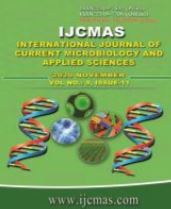


 National Academy of Agricultural Sciences (NAAS)
National Academy of Agricultural Sciences (NAAS)

|
PRINT ISSN : 2319-7692
Online ISSN : 2319-7706 Issues : 12 per year Publisher : Excellent Publishers Email : editorijcmas@gmail.com / submit@ijcmas.com Editor-in-chief: Dr.M.Prakash Index Copernicus ICV 2018: 95.39 NAAS RATING 2020: 5.38 |
A field experiment was conducted at the College Farm, Navsari Agricultural University, Navsari (Gujarat) during the rabi and summer seasons of 2018 and 2019to study the residual effect of integrated nutrient management treatments imposed in preceding chickpea on succeeding fodder maize crop. The treatments in rabi chickpea consisted of viz., T1 - 100% RDF (20 N + 40 P2O5 + 00 K2O kg/ha), T2 - 75% RDF, T3 - 100% RDF + Rhizobium + PSB, T4 - 75% RDF + Rhizobium + PSB, T5- control. These treatments were replicated four times in randomized block design.Insucceding summer season, each main plotwas splitted into four sub-plots for fodder maize with treatments consisting of varying fertility levels viz., S1 - 100% RDF (80 N + 40 P2O5 + 00 K2O kg/ha), S2 - 75% RDF, S3 - 50% RDF and S4 - control to fodder maize resulting in twenty treatment combinations replicated four times in split plot design. Treatments 100% RDF + Rhizobium + PSB (T3), 100 % RDF(T1) and 75% RDF + Rhizobium + PSB(T4) showed significantly improvement in growth and yield attributes, yields and available nutrient status in soilin fodder maize. Among the four fertility levels directly applied in fodder maize, application of 100% RDF (S1) significantly highest all growth and yield attributes, available nutrient status in soil.
 |
 |
 |
 |
 |